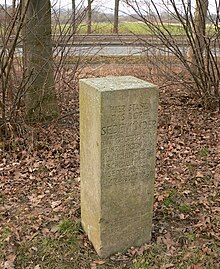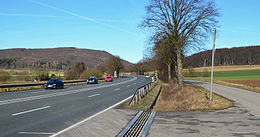Sedemuender

Sedemünder , formerly also called Södemünder , is a deserted settlement and is now a residential area in Springe in Lower Saxony . The settlement once north of the Altenhagen district existed from at least the 13th century and was probably abandoned in the 16th century. The battle of Sedemünder from 1260 was named after this settlement . A few hundred meters from the former settlement, with some buildings, is today's Sedemünder residential area.
Desolation
The exact location of the settlement is not known. It is believed to be about one kilometer south of the Deisterpforte and east of today's Sedemünder residential area. This is an area on arable land between the B 217 and the edge of the forest of the Kleiner Deister .
The time when Sedemünder was founded is unknown. Since a battle that took place in 1260 is named after the settlement, it can be assumed that it existed at that time. In the neighboring Calenberger Land , around 50% of the villages fell into desolation in the late medieval desert period in the 14th and 15th centuries.

The settlement was first mentioned in documents in 1401, when the Brunswick dukes Friedrich I and Erich bequeathed the Bailiwick of Zedemunde to a Gottschalk von Cramme as a fief . Another mention was made in 1510 before the Reformation , when a church in Sedemünder was mentioned, whose rights were transferred to the church in Altenhagen. From this it is concluded that the settlement existed until about the 16th century.
Due to the similarity of the name to the place name of the nearby Münder , it is believed that Sedemünder was a forerunner of this city, which developed while the settlement fell. In the area of the presumed desertion site, a memorial stone erected by the Heimatbund Springe in 1975 commemorates the former village of Sedemünder.
Living space
Today, the Sedemünder residential area ( 52 ° 11 ′ 16.8 ″ N , 9 ° 31 ′ 22.4 ″ E ) with several buildings, a restaurant and an abandoned factory is located some distance from the suspected deserted site . It lies in the headwaters of the Sedemünder Mühlbach . There are several fish ponds fed by spring water , including a fishing water with around 0.8 hectares of water in an alder forest .
Shortly before the Thirty Years' War, a paper mill was founded in today's settlement area . It was powered by the spring water that was dammed up in a pond. The pure spring water without iron contamination was particularly suitable for paper production. The mill was in production until the end of the 19th century.
From 1904, the processing of asbestos began in the old plants in Sedemünder , which continued until the 1950s or 1960s. Various products were made from the material, such as fireproof clothing and insulation boards for shipbuilding. In 1967 the decommissioned and partly burnt-out factory was rebuilt and converted to beverage production with the support of the Braunschweig packaging manufacturer Schmalbach-Lubeca . The plant was one of the first German bottling plants for beverage cans . The manufactured products such as Sinalco , Pepsi , Afri-Cola , Bluna as well as beer cans for breweries were delivered to Germany and abroad. After takeovers by Doornkaat and the Holsten brewery in the 1980s, the plant was closed in 1990 and has been idle ever since.
literature
- Achim Gercke : Sedemünder - the older Münder in the Sünteltal. The story of a lost village. Adensen 1975
Individual evidence
- ↑ Sedemünde paper mill
- ↑ Ulrich Manthey, Klaus Vohn-Fortagne: The history of the paper mill in: Industrial history of the Deister-Süntel area (= Hallermunter writings. Vol. 1). Museum in the Burghof, Springe 1996
- ↑ Ulrich Manthey, Klaus Vohn-Fortagne: Asbestos production in Sedemünder in: Industrial history of the Deister-Süntel area
- ↑ Ulrich Manthey: Püschel-Fruchtborn Fruchtsaft Kelterei Sedemünder GmbH in: Industrial history of the Deister-Süntel area